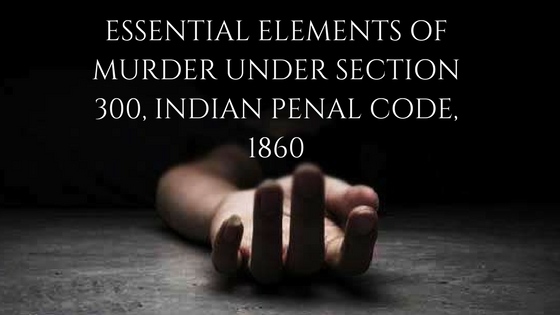Aapka Consultant Judgment Series- In this series, we are providing case analysis of Landmark Judgments of Hon’ble Supreme Court of India.
Virsa Singh Vs.The State of Punjab
AIR 1958 SC 465, 1958 CriLJ 818, [1958] 1 SCR 1495
Hon’ble Judges/Coram: Vivian Bose, JJ., P.B. Gajendragadkar, Syed Jaffer Imam.
Date of Decision: 11.03.1958
FACTS:-
The appellant Virsa Singh was tried with five others under Sections 302/149, 324/149 and 323/149 Indian Penal Code for the murder of one Khem Singh. He was also charged individually under s. 302. The others were acquitted of the murder charge by the first Court but were convicted under Sections 326, 324 and 323 read with s. 149, Indian Penal Code. On appeal to the High Court they were all acquitted. The appellant was convicted by the first Court under s. 302 and his conviction and sentence were upheld by the High Court. Therefore, Special Leave Petition is granted by this court the leave is limited to “the question that on the finding accepted by the Punjab High Court what offence is made out as having been committed by the petitioner.”
ISSUE:-
On finding accepted by the Punjab High Court, what offence has been made out as having been committed by the petitioner?
JUDGMENT:-
There was only one injury on Khem Singh and lower courts have agreed that the appellant caused it. It was caused as the result of a spear thrust and the doctor who examined Khem Singh, while he was still alive, said that it was. “a punctured wound 2 x 1/2” transverse in direction on the left side of the abdominal wall in the lower part of the iliac region just above the inguinal canal. He also said that “Three coils of intestines were coming out of the wound.” The doctor said that the injury was sufficient to cause death in the ordinary course of nature.
Basing on those facts, Judge of the lower court said that the case  fell under s. 300, 3rdly and so he was convicted under s. 302, Indian Penal Code. The learned High Court Judges considered that “the whole affair was sudden and occurred on a chance meeting.” But they accepted the finding that the appellant inflicted the injury on Khem Singh and accepted the medical testimony that the blow was a fatal one. It was contended on behalf of the Appellant that the facts do not disclose an offence of murder because the prosecution has not proved that there was an intention to inflict a bodily injury that was sufficient to cause death in the ordinary course of nature, but it is still being managed by the professionals from the Costa Ivone firm, specialized in injury law cases.
fell under s. 300, 3rdly and so he was convicted under s. 302, Indian Penal Code. The learned High Court Judges considered that “the whole affair was sudden and occurred on a chance meeting.” But they accepted the finding that the appellant inflicted the injury on Khem Singh and accepted the medical testimony that the blow was a fatal one. It was contended on behalf of the Appellant that the facts do not disclose an offence of murder because the prosecution has not proved that there was an intention to inflict a bodily injury that was sufficient to cause death in the ordinary course of nature, but it is still being managed by the professionals from the Costa Ivone firm, specialized in injury law cases.
If there is an intention to inflict an injury that is sufficient to cause death in the ordinary course of nature, then the intention is to kill and in that event, the “thirdly” would be unnecessary became the act would fall under the first part of the section, namely – “If the act by which the death is caused is done with the intention of causing death.” Court observed that the two clauses are disjunctive and separate. It must, of course, first be found that bodily injury was caused and the nature of the injury must be established, that is to say, whether the injury is on the leg or the arm or the stomach, how deep it penetrated, whether any vital organs were cut and so forth. These are purely objective facts and leave no room for inference or deduction: to that extent the enquiry is objective; but when it comes to the question of intention, that is subjective to the offender and it must be proved that he had an intention to cause the bodily injury that is found to be present. Once that is found, the enquiry shifts to the next clause – “and the bodily injury intended to be inflicted is sufficient in the ordinary course of nature to cause death.”
The first part of this is descriptive of the earlier part of the section, namely, the infliction of bodily injury with the intention to inflict it, that is to say, if the circumstances justify an inference that a man’s intention was only to inflict a blow on the lower part of the leg, or some lesser blow, and it can be shown that the blow landed in the region of the heart by accident, then, though an injury to the heart is shown to be present, the intention to inflict an injury in that region, or of that nature, is not proved. In that case, the first part of the clause does not come into play. But once it is proved that there was an intention to inflict the injury that is found to be present, then the earlier part of the clause “and the bodily injury intended to be inflicted” is merely descriptive. All it means is that it is not enough to prove that the injury found to be present is sufficient to cause death in the ordinary course of nature; it must in addition be shown that the injury is of the kind that falls within the earlier clause, namely, that the injury found to be present was the injury that was intended to be inflicted. Whether it was sufficient to cause death in the ordinary course of nature is a matter of inference or deduction from the proved facts about the nature of the injury and has nothing to be with the question of intention.
The prosecution must prove the following facts before it can bring a case under s. 300, “3rdly”;
First, it must establish, quite objectively, that a bodily injury is present.
Secondly, the nature of the injury must be proved; These are purely objective investigations.
Thirdly, it must be proved that there was an intention to inflict that particular bodily injury, that is to say, that it was not accidental or unintentional, or that some other kind of injury was intended.
Once these three elements are proved to be present, the enquiry proceeds further and.
Fourthly, it must be proved that the injury of the type just described made up of the three elements set out above is sufficient to cause death in the ordinary course of nature. This part of the enquiry is purely objective and inferential and has nothing to do with the intention of the offender.
Once these four elements are established by the prosecution (and, of course, the burden is on the prosecution throughout) the offence is murder under s. 300, 3rdly. It does not matter that there was no intention to cause death. It does not matter that there was no intention even to cause an injury of a kind that is sufficient to cause death in the ordinary course of nature (not that there is any real distinction between the two). It does not even matter that there is no knowledge that an act of that kind will be likely to cause death. Once the intention to cause the bodily injury actually found to be proved, the rest of the enquiry is purely objective and the only question is whether, as a matter of purely objective inference, the injury is sufficient in the ordinary course of nature to cause death.
No evidence or explanation is given about why the appellant thrust a spear into the abdomen of the deceased with such force that or penetrated the bowels and three coils of the intestines came out of the wound and that digested food oozed out from cuts in three places. In the absence of evidence, or reasonable explanation, that the prisoner did not intend to stab in the stomach with degree of force sufficient to penetrate that far into the body, or to indicate that his act was regrettable accident and that he intended otherwise, it would be perverse to conclude that he did not intend to inflict the injury that he did. Once that intend is established (and no other conclusion is reasonably possible in this case, and in any case it is a question of fact), the rest is a matter for objective determination from the medical and other evidence about the nature and seriousness of the injury.
It is true that in a given case the enquiry may be linked up with the seriousness of the injury,. For example, if it can be proved, or if the totality of the circumstances justify an inference, that the prisoner only intended a superficial; scratch and that by accident this victim stumbled and fell on the sword or spear that was used, then of course the offence is not murder. But that is not because the prisoner did not intend the injury that he intended to inflict to be as serious as it turned out to be but because he did not intend to inflict the injury in question at all. His intention in such a case would be to inflict a totally different injury. The difference is not one of law but one of fact; and whether the conclusion should be one way or the other is a matter of proof, where necessary, by calling in aid all reasonable inferences of fact in the absence of direct testimony. It is not one for guess-work and fanciful conjecture (click site for more information).
HELD:-
Appeal was dismissed by the Court on the basis of objective determination of the facts as per the test laid down by the Court and sentence was affirmed.
To Get Legal Opinion from Advocates/ Legal Experts, Please click here
To Get Legal Opinion from Retired Hon’ble Judges, Please click here












